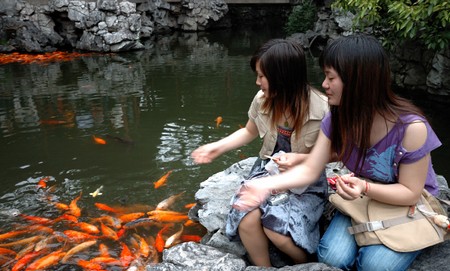Providing clean water and supplying the correct, balanced food, are the two most important considerations we can give our fish. Feeding is a crucial, life-giving (or life-taking if it is done badly) part of the maintenance programme. Don’t forget, also, that sheer pleasure can be had from seeing a clutch of champing mouths eagerly respond to our scatterings. Feeding fish is as much a bonding exercise as it is providing sustenance.
Fish are generally omnivorous, naturally eating both plant and animal material, some species scouring the bottom of the pond for worms, shrimps, algae and even decaying detritus. So, if fish can survive without help in the wild, do our pond fish actually need any supplementary food from us? If you possess a lush wildlife pond teeming with insects and crustaceans, and have only a few fish, then the answer would be ‘no’. However, most pond set-ups mean that providing supplementary food is the safest option for maintaining a healthy stock of fish.

Do not be tempted to feed your fish at all if the temperature drops below 7°C (44°F). It is actually harmful to feed fish when it is so cold that their metabolic processes, including digestion, slow right down, increasing the danger of food rotting inside the gut. Between 7-14°C (44-57°F), easily digestible foods with high wheatgerm content can be introduced. When the water temperature stabilizes above 15°C (59°F), high protein, growth-inducing feed can be used; increase the frequency of meals to two or three times a day as the temperature rises.
Skim off any remaining food from the surface of your pond if it has been uneaten after ten minutes or so. Failing to do this will result in surplus food falling to the bottom to be fed on by bacteria, whose toxic by-products can poison fish.
The main types of pond fish food are manufactured flakes and pellets, frozen aquatic organisms and live food. When buying manufactured food, look out for types that float well, bringing the fish to the surface to feed. Choose a size of food that is appropriate to your fish.
Like us, fish need a balanced diet, so check the packet to ensure that the protein content -fishmeal, soya and egg mainly – is around 30% for summer foods. For spring and autumn feeding change to makes with higher carbohydrate (wheatgerm-based) levels. Vitamin C boosts fish immunity to disease, and is added to some higher quality foods.
Frozen food is well worth tracking down. It generally comes in all the same varieties as live food and can be stored in your freezer. Some brands are gamma irradiated prior to freezing to kill off the pathogenic parasites and bacteria that can cause fish diseases if introduced to your pond via live food.
If you wish to adopt an overall more organic approach to feeding your fish, it is possible to buy many of the organisms that fish would encounter in the wild. Earthworms, chopped lettuce, the occasional slice of orange (peel and all), are all nutritious additions. Even grass clippings are devoured by the grass carp, but make sure that no weedkillers or noxious chemicals were used on the lawn previously.